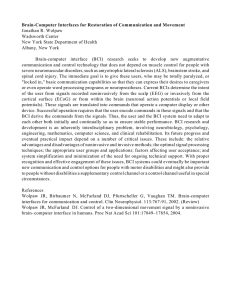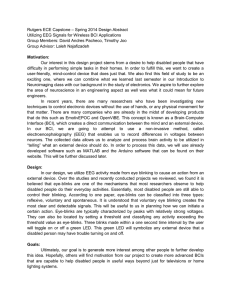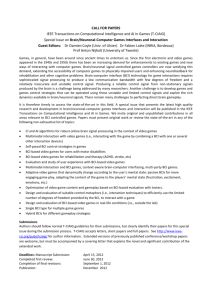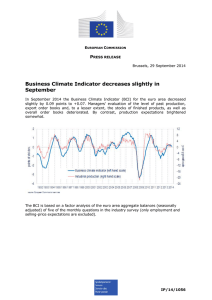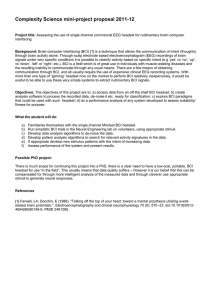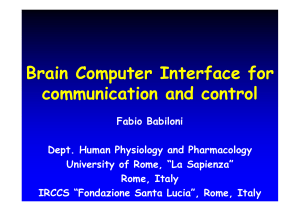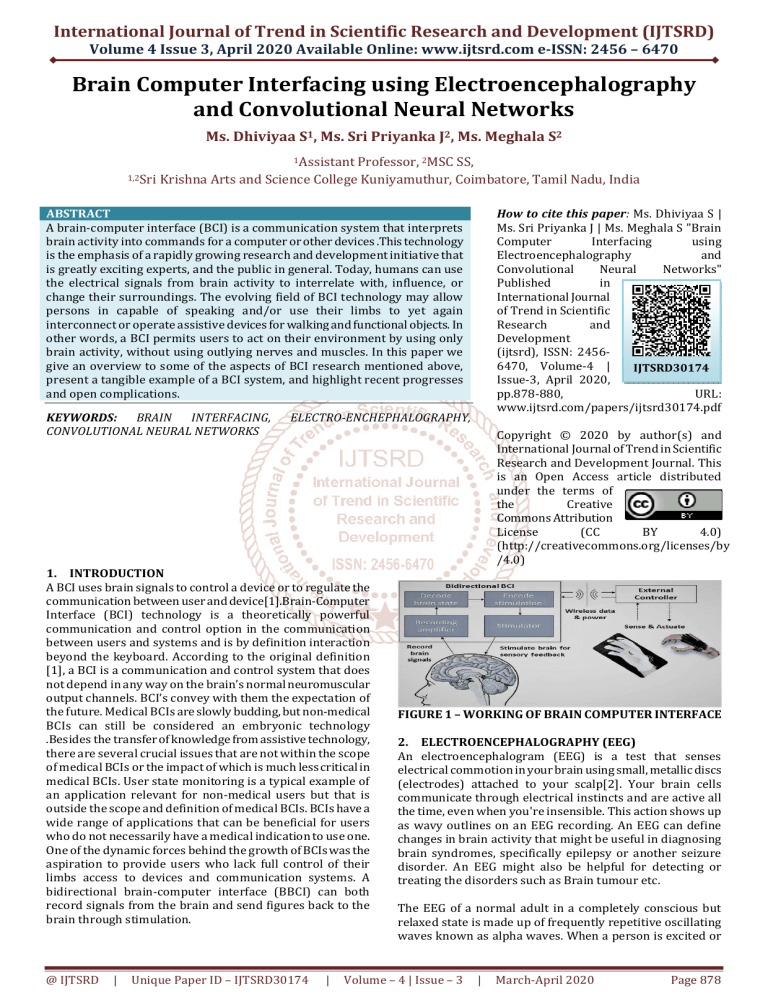
International Journal of Trend in Scientific Research and Development (IJTSRD)
Volume 4 Issue 3, April 2020 Available Online: www.ijtsrd.com e-ISSN: 2456 – 6470
Brain Computer Interfacing using Electroencephalography
and Convolutional Neural Networks
Ms. Dhiviyaa S1, Ms. Sri Priyanka J2, Ms. Meghala S2
1Assistant
Professor, 2MSC SS,
1,2Sri Krishna Arts and Science College Kuniyamuthur, Coimbatore, Tamil Nadu, India
ABSTRACT
A brain-computer interface (BCI) is a communication system that interprets
brain activity into commands for a computer or other devices .This technology
is the emphasis of a rapidly growing research and development initiative that
is greatly exciting experts, and the public in general. Today, humans can use
the electrical signals from brain activity to interrelate with, influence, or
change their surroundings. The evolving field of BCI technology may allow
persons in capable of speaking and/or use their limbs to yet again
interconnect or operate assistive devices for walking and functional objects. In
other words, a BCI permits users to act on their environment by using only
brain activity, without using outlying nerves and muscles. In this paper we
give an overview to some of the aspects of BCI research mentioned above,
present a tangible example of a BCI system, and highlight recent progresses
and open complications.
KEYWORDS: BRAIN
INTERFACING,
CONVOLUTIONAL NEURAL NETWORKS
ELECTRO-ENCHEPHALOGRAPHY,
Copyright © 2020 by author(s) and
International Journal of Trend in Scientific
Research and Development Journal. This
is an Open Access article distributed
under the terms of
the
Creative
Commons Attribution
License
(CC
BY
4.0)
(http://creativecommons.org/licenses/by
/4.0)
1. INTRODUCTION
A BCI uses brain signals to control a device or to regulate the
communication between user and device[1].Brain-Computer
Interface (BCI) technology is a theoretically powerful
communication and control option in the communication
between users and systems and is by definition interaction
beyond the keyboard. According to the original definition
[1], a BCI is a communication and control system that does
not depend in any way on the brain’s normal neuromuscular
output channels. BCI’s convey with them the expectation of
the future. Medical BCIs are slowly budding, but non-medical
BCIs can still be considered an embryonic technology
.Besides the transfer of knowledge from assistive technology,
there are several crucial issues that are not within the scope
of medical BCIs or the impact of which is much less critical in
medical BCIs. User state monitoring is a typical example of
an application relevant for non-medical users but that is
outside the scope and definition of medical BCIs. BCIs have a
wide range of applications that can be beneficial for users
who do not necessarily have a medical indication to use one.
One of the dynamic forces behind the growth of BCIs was the
aspiration to provide users who lack full control of their
limbs access to devices and communication systems. A
bidirectional brain-computer interface (BBCI) can both
record signals from the brain and send figures back to the
brain through stimulation.
@ IJTSRD
|
How to cite this paper: Ms. Dhiviyaa S |
Ms. Sri Priyanka J | Ms. Meghala S "Brain
Computer
Interfacing
using
Electroencephalography
and
Convolutional
Neural
Networks"
Published
in
International Journal
of Trend in Scientific
Research
and
Development
(ijtsrd), ISSN: 24566470, Volume-4 |
IJTSRD30174
Issue-3, April 2020,
pp.878-880,
URL:
www.ijtsrd.com/papers/ijtsrd30174.pdf
Unique Paper ID – IJTSRD30174
|
FIGURE 1 – WORKING OF BRAIN COMPUTER INTERFACE
2. ELECTROENCEPHALOGRAPHY (EEG)
An electroencephalogram (EEG) is a test that senses
electrical commotion in your brain using small, metallic discs
(electrodes) attached to your scalp[2]. Your brain cells
communicate through electrical instincts and are active all
the time, even when you're insensible. This action shows up
as wavy outlines on an EEG recording. An EEG can define
changes in brain activity that might be useful in diagnosing
brain syndromes, specifically epilepsy or another seizure
disorder. An EEG might also be helpful for detecting or
treating the disorders such as Brain tumour etc.
The EEG of a normal adult in a completely conscious but
relaxed state is made up of frequently repetitive oscillating
waves known as alpha waves. When a person is excited or
Volume – 4 | Issue – 3
|
March-April 2020
Page 878
International Journal of Trend in Scientific Research and Development (IJTSRD) @ www.ijtsrd.com eISSN: 2456-6470
startled, the alpha waves are substituted by low-voltage
rapid irregular waves. During sleep, the brain waves become
tremendously slow. Other abnormal circumstances are
connected with certain EEG configurations. For example,
irregular slow waves known as delta waves arise from the
vicinity of a localized area of brain impairment [3]. Some of
the techniques [4] used in Electroencephalography in brain
computer interface are discussed below.
FIGURE 2- ELECTROENCHEPHALOGRAPH
A. Slow Cortical Potential
Slow Cortical Potentials (SCPs) are based on electrical
movement in the brain usually less than 1Hz. The SCPs are
produced by several mechanisms. These comprise (a) slow
graded post-synaptic potentials of the giant pyramidal cells
in the cortex (usually going down to around 0.5Hz)- these
are usually oscillating signals. (b) The major source of SCPs
is the glial cells that support and regulate the neurons and
are thoroughly related to brain instigation and brain
constancy [4].
equipment, has led to innovative applications in the
operating theatre and intensive care unit (ICU)—at a time
when the role of EPs in the valuation of multiple sclerosis
has largely been exchanged by magnetic resonance imaging
(MRI) [7].
3. CONVOLUTIONAL NEURAL NETWORKS
A classifier based on a CNN seems to be a good method for
EEG organization as the signal to detect comprises a lot of
differences over time and persons. For such a variable signal,
constructions based on local kernels can be inefficient at
representing functions that must be tolerant to many
variations[8].A convolutional neural network (CNN)
classification algorithm is executed to categorize the motor
imagery (MI) experiment using novel feature 3-dimension
input.
There are various architectures of CNNs existing which have
been key in constructing algorithms which power and shall
power AI as a whole in the predictable future. Some of them
have been listed below[11]:
LeNet
AlexNet
VGGNet
GoogLeNet
ResNet
ZFNet
Positive SCPs specify decrease of cortical excitation of the
original neural structures.
FIGURE 3- CONVOLUTIONAL NEURAL NETWORKS
B. Sensorimotor Rhythms
The sensorimotor rhythm (SMR) is a brain wave. It is an
oscillatory idle measure of coordinated electric brain SMR
characteristically decreases in amplitude when the
equivalent sensory or motor areas are stimulated, e.g. during
motor tasks and even during motor imagery .Theoretically,
SMR is occasionally varied up with alpha waves of occipital
origin, the strongest source of neural signs in the EEG. One
reason might be, that without appropriate spatial clarifying
the SMR is very inspiring to detect since it is usually flooded
by the stronger occipital alpha waves. The feline SMR has
been noted as being analogous to the human mu rhythm
activity. For most persons, the rate of the SMR is in the range
of 13 to 15 Hz [5].
C. Evoked Potentials
An evoked potential is an electrical potential in a certain
form detailed from a exact portion of the nervous system,
specifically the brain, of a human or other creatures
following demonstration of a stimulus. Different categories
of potentials result from stimuli of different modalities and
types [6].
EPs have the benefits of being objective, frequently more
sensitive than inclusive neurological inspection, and they can
be recorded in patients who are sedated or comatose. The
concluding fact, along with enhancements in recording
@ IJTSRD
|
Unique Paper ID – IJTSRD30174
|
4. BENEFITS AND RISKS IN BC
Though constant research has led to the progress of several
applications of Brain Computer Interface (BCI) technology
and its benefits in various fields, there are a little risks
related with brain computer interface, which can be a
remarkable limitation to technological development[12].
4.1. BENEFITS
A. Technology that is ‘smart’
One of the biggest reasons why BCI is deemed as advanced
technology is because it can make formerly passive
strategies into ‘smart’ and lively ones. An illustration of such
devices is prosthetics[12].
B. Telepresence
Telepresence is a knowledge that gives the capability to
someone to make their presence felt, at a remote location,
with the help of telerobotics. Telepresence, with the
integration of BCI, can give military personnel the ability to
keep an eye on any apprehensive activity that might take
place at the border. Telepresence can thus detect any
suspicious activity and help fight it[12].
C.
Fewer accidents
Car-related accidents are one of the most severe reasons of
death worldwide. A BCI-enabled car can thus avert any such
Volume – 4 | Issue – 3
|
March-April 2020
Page 879
International Journal of Trend in Scientific Research and Development (IJTSRD) @ www.ijtsrd.com eISSN: 2456-6470
occurrence from occurring by distinguishing what is going
on in the driver’s mind and by taking the choice in just a
matter of seconds. Automobile manufacturer Nissan has
revealed that it is leading research on a BCI-enabled car
control scheme that will allow the system to slow the vehicle
or turn the steering wheel faster than the driver himself.
This technical invention can potentially be a major
breakthrough in the automobile production[12].
Even progressive BCIs that could perceive neural activity
associating with complex semantic processing might not be
adequate to show that the subject had the intellectual and
passionate capacity to make an informed and autonomous
decision about life-sustaining treatment. Some form of
behavioural interaction may be essential to check that the
subject had this capacity. Medical specialists and caregivers
must be careful not to read too much into BCI-enabled
responses and understand them as having a denotation they
lack [13].
4.2. RISKS
One of the basic restrictions of BCI is that the signals
acknowledged from the brain are prone to intrusion.
Additionally, legal and ethical apprehensions such as the risk
of infection or haemorrhage harm caused when a patient's
aim to control an external device fails as well as privacy and
privacy of patients' data are some of the challenges
confronted by BCI in healthcare. Nevertheless, important
attention has not been paid to the challenges that delay the
enactment of BCI in healthcare [14] .
surgeons that we belong to will be in charge of knowing and
assimilating new technology, to deliver better care to our
patients [15].
References:[1] Jan B. F. van Erp,Michael Tangermann,Fabien
Lotte“BrainComputer_Interfaces_Beyond_Medical_App
lications”
[2] https://www.mayoclinic.org/testsprocedures/eeg/about/pac-20393875
[3] https://www.britannica.com/science/electroencephal
ography
[4] http://neurofeedbackalliance.org/slow-corticalpotential-training/
[5] https://en.wikipedia.org/wiki/Sensorimotor_rhythm
[6] https://en.wikipedia.org/wiki/Evoked_potential
[7] P Walsh, N Kane, S Butler “The clinical role of evoked
potentials “BMJ journals -Journal of neurology
neurosurgery and psychiatry volume 76, Issue suppl 2.
[8] (PDF) Convolutional Neural Networks for P300
Detection with Application to Brain-Computer
Interfaces.
Available
from:
https://www.researchgate.net/publication/44691515
_Convolutional_Neural_Networks_for_P300_Detection_
with_Application_to_Brain-Computer_Interfaces
[accessed Jan 09 2020].
[9] YuZhang ,XiongZhang, HanSun, ZhaowenFan,
XuefeiZhong “Computers in Biology and Medicine”
Volume 107, April 2019, Pages 248-256
[10] https://towardsdatascience.com/a-comprehensiveguide-to-convolutional-neural-networks-the-eli5-way3bd2b1164a53
[11] https://www.allerin.com/blog/exploring-the-benefitsand-risks-of-brain-computer-interface
[12] Glannon, Walter. “Ethical issues with brain-computer
interfaces.”Frontiers in systems neuroscience vol. 8
136. 30 Jul. 2014, doi:10.3389/fnsys.2014.00136
FIGURE 4 – TECHNOLOGICAL RISKS IN BCI
5. CONCLUSION
The potentials of BCI technology are nowhere near fatigued.
The rise of non-invasive BCI devices — based off an EEG — is
symbolic of future mainstream approachability of BCI
technology. For example, BCI technology can allow users to
create music with their views. The specific device for this is
called an encephalophone, which is measured by the
pictorial or motor cortex. The device mechanisms by
receiving input from cortical signals such as the posterior
dominant rhythm (PDR) from the visual cortex or else the
mu signal from the motor cortex. This technology can be
used by persons who suffer from neurodegenerative
circumstances, but most likely will also become a typical
product.
In conclusion, BCI has increasingly attained several
monumental milestones. The forth coming influence of BCI
in terms of patient care is slowly beginning to come into
focus. It is important to think of that the generation of
@ IJTSRD
|
Unique Paper ID – IJTSRD30174
|
[13] Iroju Olaronke,Rhoda Ikono, IshayaGambo, Oluwaseun
AdeniyiOjerinde, Olaleke Janet “Prospects and
Problems of Brain Computer Interface in Healthcare
“October 2018Current Journal of Applied Science and
Technology
29(6):1-17DOI:
10.9734/CJAST/2018/44358”
[14] Daniel Gomez Ramos ,Ohio University Heritage College
of Osteopathic Medicine,“The Future of Brain
Computer Interface Technology”Published on January
22, 2018
[15] IouliettaLazarou, Spiros Nikolopoulos, Panagiotis C.
Petrantonakis, IoannisKompatsiaris, MagdaTsolaki
“EEG-Based
Brain–Computer
Interfaces
for
Communication and Rehabilitation of People with
Motor Impairment: A Novel Approach of the 21st
Century”
Volume – 4 | Issue – 3
|
March-April 2020
Page 880

